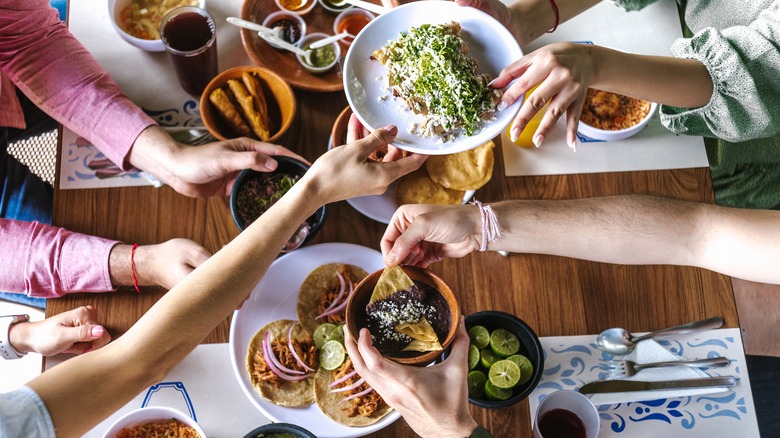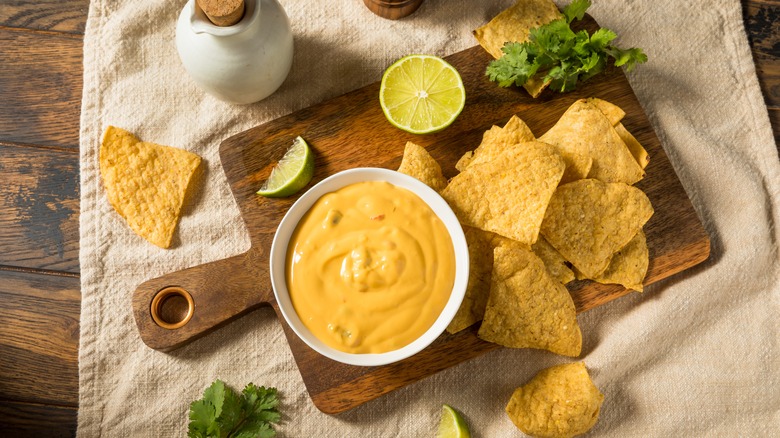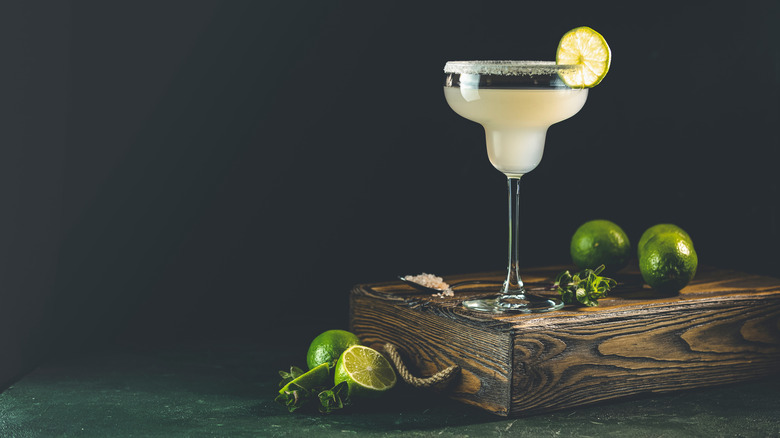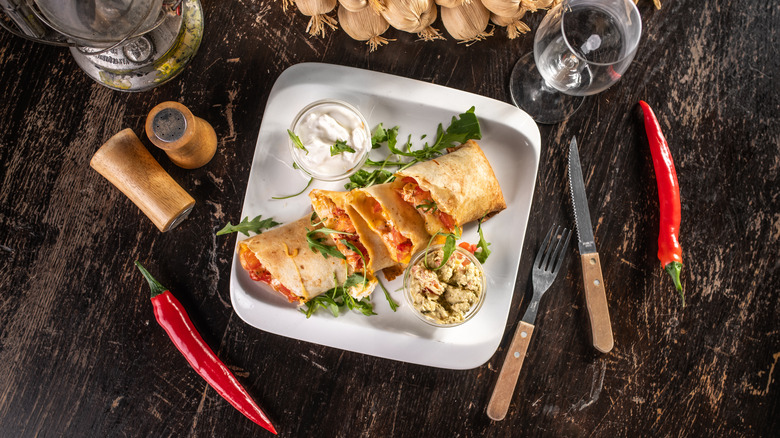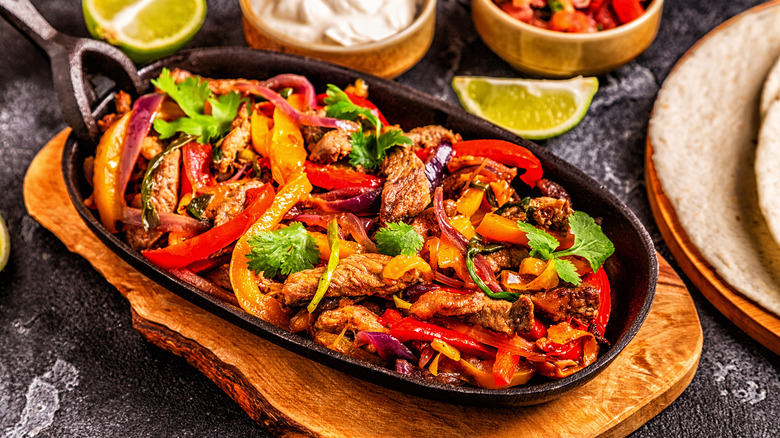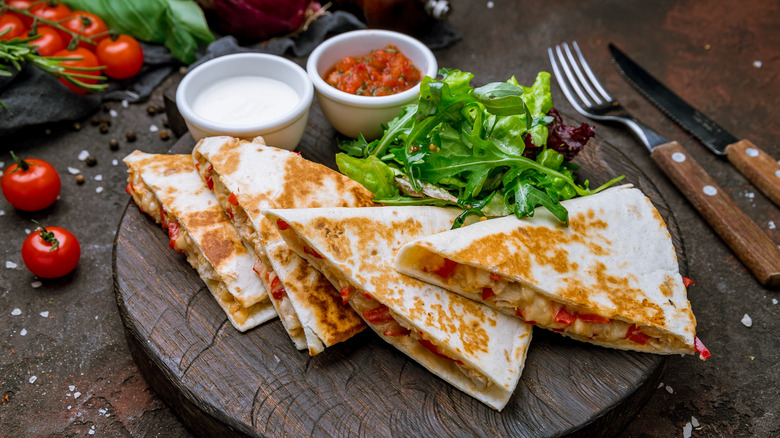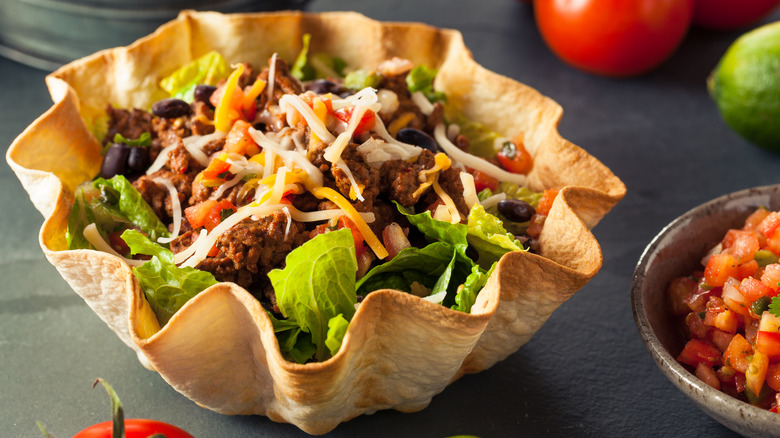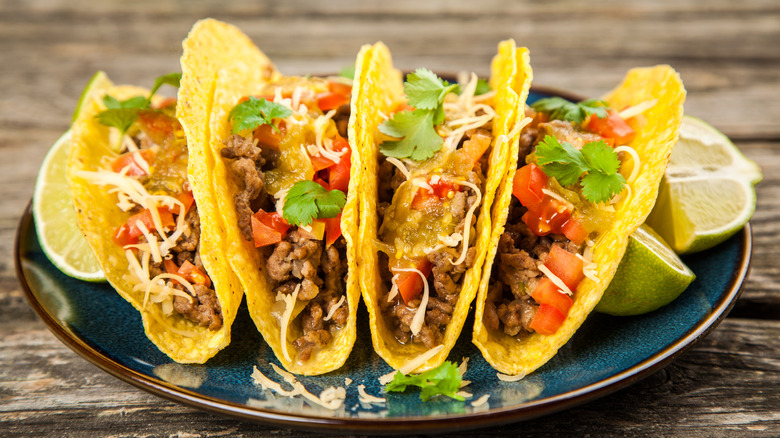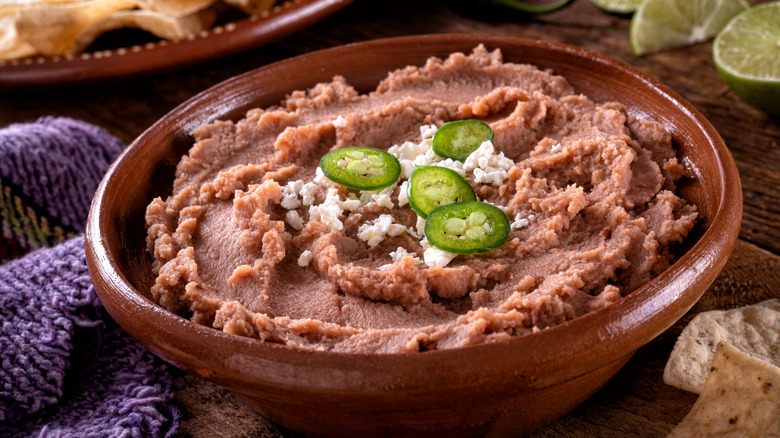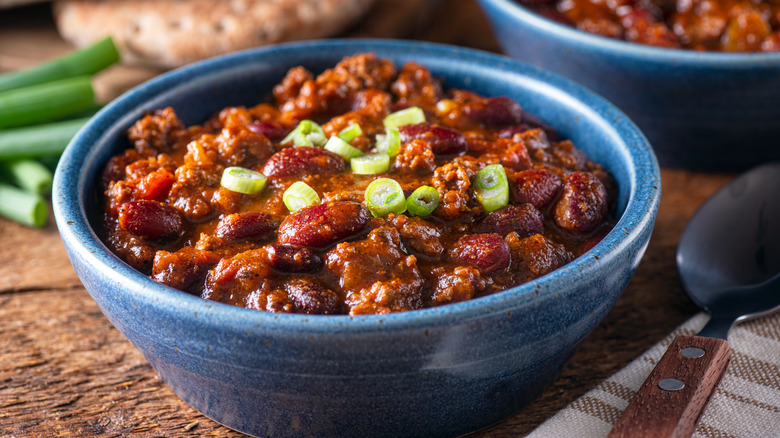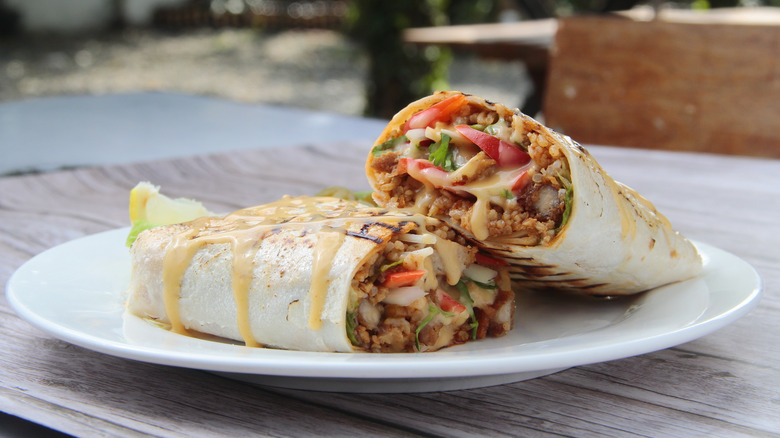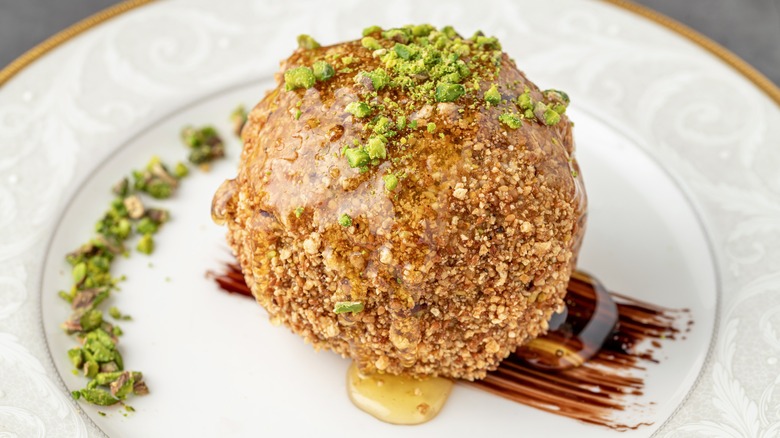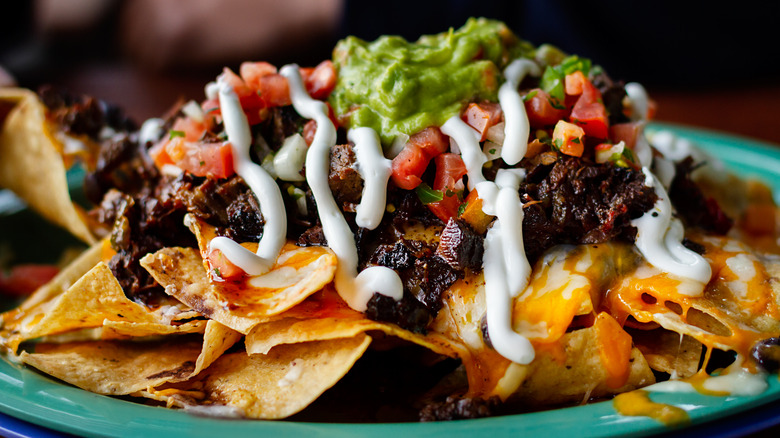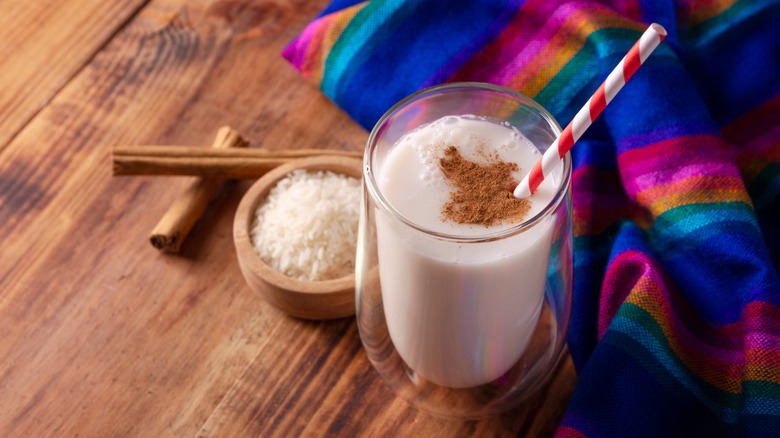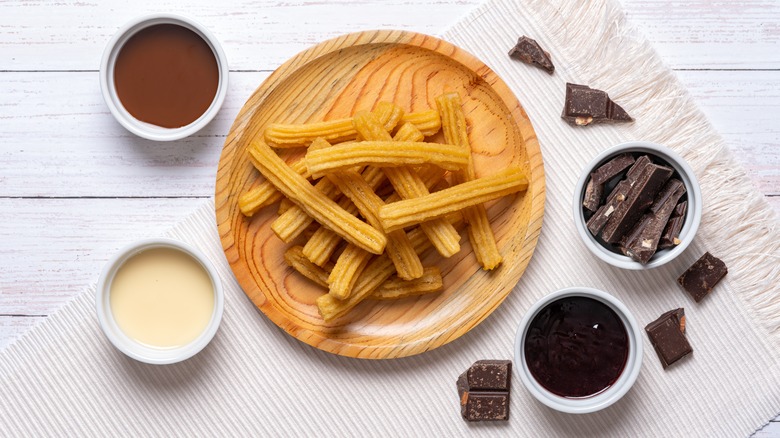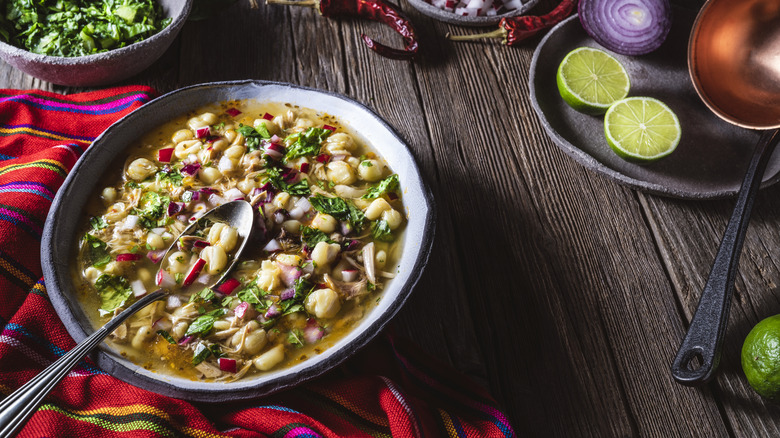14 Dishes You Should Never Order At A Mexican Restaurant
Mexican food is popular for a reason — it's affordable, quick, and delicious. It is also representative of the global proliferation of foodways thanks to the mechanization of food production throughout the 20th century, per On The Gas. What we see as "Mexican food" in restaurants represents not just decades, but centuries of evolution. From the arrival of Spanish conquistadors in what is now Mexico to the spread of Mexican culinary heritage across the U.S. and beyond, Mexican cuisine — as represented by restaurant fare — speaks to the ways in which culinary habits diffuse from culture to culture. They adopt locally sourced foods and incorporate endemic food preparation techniques to create a completely unique gastronomic custom.
This globalization comes with both critics and fans, chiefly in response to the sense that somehow indigenous flavors and techniques are being coopted and bastardized. While this may be true to some extent, inauthenticity may not be the only reason to opt out of eating a particular dish at a Mexican restaurant. Other considerations include the nutritional value and health ramifications of "Americanized" Mexican food, as WebMD points out. Our penchant for super-sized, deep-fried, cheese-saturated versions of Mexican food can be a disaster for our waistlines and our cardiovascular health. It is through this multi-faceted lens that we will take a look at the foods you should never order at a Mexican restaurant.
1. Queso
We know — cheese is quite possibly the perfect food. However, when you are talking about things you should just skip the next time you are planning on eating out at a Mexican restaurant, queso is probably the last thing you should order. First off, as Reader's Digest suggests, there is nothing authentic about a bowl of melted cheese. In fact, most traditional Mexican fare isn't cheese-centric at all. And if there is cheese, it is definitely not of the processed varietal, orange in color, or greasy in texture. It's more likely something like a Queso Fresco, which is a soft, crumbly, fresh cheese similar to feta that is light in flavor and juxtaposes the spices in Mexican cuisine perfectly.
Additionally, per WebMD, queso is literally the pinnacle of the most unhealthy items on the menu at a Mexican restaurant. It's loaded with saturated fat and packs a hefty punch in terms of calories. For a more waistline-friendly option, stick to the salsa and guacamole. They are not only more traditional, but both are also loaded with nutrients and minerals that are actually good for you. Just watch out for how many tortillas you are dunking in them, as they can be salty and calorically dense.
2. Margaritas
We can't believe we are saying this, but if you plan to order an alcoholic beverage at a Mexican restaurant, don't make it a margarita. Sacrilege we know, but according to Insider, chefs agree — restaurant margaritas are often made with a pre-bought mix loaded with sugar and are watered down with cheap quality tequila. It's a waste of money and calories. The average restaurant margarita contains a whopping 300 calories per beverage and has 31 grams of sugar, per Healthline, which is well above the average recommended limit of sugar per person per day, according to the American Heart Association.
And a margarita is really not a traditional beverage in Mexico (via Reader's Digest). Tequila of course does come from Mexico, but margaritas are often only available in super touristy restaurants catering to travelers. For a more legitimate Mexican delight, try a grapefruit-flavored cocktail called a Paloma. The name literally translates to "dove" in Spanish, although we aren't sure how that moniker pertains to this refreshing combination of tequila, lime juice, and grapefruit soda. Either way, it's the perfect accompaniment to your next Mexican feast.
3. Chimichangas
The allure of a deep-fried anything is almost as American as apple pie. It's no surprise that the burrito — arguably delicious on its own merit — should also meet this deep-fried fate in the form of a chimichanga. Topped with copious quantities of cheese, sour cream, guacamole, and olives, the chimichanga can rack up an astounding 810 calories and 43 grams of fat, according to Health Digest. This makes it one of the most unhealthy options you can order at a Mexican restaurant, according to nutritionists.
Chefs agree that you should stay away from the chimichanga, but for slightly different reasons (via Insider). While they too note the bang for your buck in terms of calories and fat not being worth it, their reason has more to do with taste — namely the way in which deep frying can mute the flavors of the fillings within the burrito. They also cite that the chimichanga is decidedly not authentic Mexican fare, but rather a Tex-Mex mash-up. That doesn't mean it can't be worth eating, but in this case, we recommend getting your meat and cheese fix in a different delivery format.
4. Fajitas
Sizzling fajitas are something that involves a multi-sensory experience when ordered at a Mexican restaurant. Between the show of the fajitas being brought to the table, the smells of the meat and veggies on the cast iron, and the process of slowly assembling the perfect bite, the fajita feels a bit... theatrical. Chefs, however, suggest that the fajita is really an overpriced simplistic dish that would be better executed at home with higher-quality ingredients (via Insider). Nutritionists agree, noting that restaurant fajitas are often loaded with fatty toppings and served in obscene portion sizes, per Health Digest. They cite Applebee's steak fajitas as an example, noting that it packs 1,560 calories and 90 grams of fat into one serving size.
Additionally, while historically fajitas were made with the highest quality skirt steak, this is seldom the case due to the high cost of skirt steak and a 1988 agreement between the U.S. and Japan ensuring that most of the skirt steak produced in this country gets exported. Restaurants today typically use an assortment of mystery meats labeled "beef for fajitas," which is composed of remnants of random cuts of lower-quality beef, including the tough flank steak. Because these cuts are from the bottom of the barrel, they often require some assistance in the form of chemical meat tenderizers to make them palatable. In short, we'd skip the adulterated mostly-beef fajitas and save your calories for something more wholesome and flavorful.
5. Quesadilla
While "quesadilla" means "little cheese pastry" in Mexican Spanish, what you typically get in a Mexican restaurant is hardly little, nor would we describe it as a pastry. In fact, according to WebMD, it's one of the worst things you can order at a Mexican restaurant.
An enormous portion of meat and cheese tucked in between two large flour tortillas that is pan-fried and garnished with heaps of sour cream and guacamole takes what can typically be a cheap and easy homemade meal and elevates it into a cardiovascular catastrophe. Per Livestrong, one cheese quesadilla can contain 714 calories, 45 grams of fat, and an astounding 1,360 milligrams of sodium. Throw in some meat and you have a belly bomb of epic proportions. We suggest saving this as a treat to make at home where you can control the ingredients you add, the portion size, and perhaps opt for a whole wheat tortilla.
6. Taco Salad
People think they are making a healthy choice when opting for a salad — but with a fried tortilla shell, loads of sour cream, refried beans, and meat, this is actually one of the most calorie-laden offerings you can get at a Mexican restaurant (via WebMD). The taco shell alone is responsible for almost half of the calories you are consuming even though, let's be honest, a deep-fried tortilla shell is delectable.
While you can make some adjustments to your order to lighten things up — like skipping the shell, choosing chicken instead of beef, and getting the accouterments on the side — we recommend simply skipping it at a Mexican restaurant. Instead, you can make a healthier version of taco salad at home, setting up a taco salad bar of sorts where people can add whatever toppings they desire. This will enable you to incorporate more fresh vegetables and you can still get your fried tortilla fix by making little fried tortilla strips to add as a garnish. It's a win-win, and sure to be a popular, more affordable Mexican-themed dinner tradition for the whole family to savor.
7. Hard Shell Tacos
According to BBC the hard shell taco was invented by an immigrant couple from Jalisco, Mexico in 1937. Salvador and Lucia Rodriguez introduced the novelty at their Mexican-American restaurant Mitla Café, located in San Bernardino, California. While the notion was loosely based upon something Lucia grew up with, the hard shell taco was born out of necessity — namely using up whatever ingredients were on hand. The idea was then popularized by none other than Taco Bell, who has arguably made it one of the most popular food items on Mexican restaurant menus.
Certainly, the hard shell taco is appealing thanks to its fried shell, affordability, and simplicity — however, there is nothing resembling it in Mexico itself (via The Travel). The closest thing you will find there are flautas and taquitos. Tacos in Mexico are typically made with soft tortillas and filled with a myriad of ingredients including seafood, carnitas, and carne asada, but never with ground beef (via UW). These tacos are then topped with a refreshing combination of onions, cilantro, pico de gallo, radishes, cucumbers, avocado, chili peppers, and a squirt of lime juice.
The next time you are at a Mexican restaurant, skip the hard shell tacos and ask for tacos the Mexican way. They are sure to be fresher and healthier and will titillate your taste buds with the perfect blend of textures, flavors, and acidity.
8. Refried Beans
While refried beans are a staple side dish at almost every Mexican restaurant, it might be best to skip them the next time you are eating out. Beans themselves may seem like a healthy option, however refried beans are often cooked in copious quantities of lard, seasoned with excess salt, and topped with cheese. One cup can easily contain 10 grams of fat and a boatload of sodium (via WebMD). To satisfy your bean cravings, it is recommended that you substitute black beans, which are loaded with fiber, protein, and antioxidants.
Another reason to skip the refried beans? They have been known to be the cause of food-borne illness outbreaks. In 2018, 170 consumers became ill with Clostridium Perfringens due to refried beans being kept at an "unsafe temperature" by a Chipotle franchise. Apparently, beans are particularly susceptible to this type of bacteria that can cause gastrointestinal issues like nausea, diarrhea, and fever. Unless you are certain that the restaurant you are dining at is carefully monitoring how they hold their beans, you might want to pass the next time you are dining out.
9. Chili Con Carne
Considered the "state food of Texas," chili has as complex a history as recipes for it have variations, per What's Cooking America. The earliest documentation of chili carne dates to 1926 when J.C. Clopper loosely described a stew made with meat and peppers that was widely available for impoverished people to consume. However, further analysis reveals that something like chili carne may have emerged as far back as the 17th century.
Whatever permutation of the legend of the origins of chili you ascribe to, what is sure is that chili is in no way a dish of Mexican descent. As described in the "Diccionario de Mejicanismos" of 1959, chili con carne is said to be "detestable food passing itself off as Mexican, sold in the U.S. from Texas to New York." While we don't consider it detestable, we do recommend you skip ordering it at a Mexican restaurant and opt to either make it at home or enjoy it at one of the many chili cook-offs that dot the country annually. Now the only debate is — beans or no beans — which is the topic for another heated debate.
10. Burritos
There are so many reasons to forgo the burrito at a Mexican restaurant, least of which is the fact that it is most certainly not authentic Mexican cuisine, but rather a super-sized bastardization of a classic Mexican taco (via Reader's Digest). Burritos are also a nutritional nightmare, with many deluxe versions packing in a whopping 900 calories per serving, according to WebMD.
But maybe the best reason not to order a burrito from a Mexican restaurant is a financial one. Burritos tout themselves as an affordable alternative to other options, and yet, sometimes you get what you pay for. Many restaurants will substitute more expensive ingredients with copious quantities of rice as a filler to round out your burrito, making it both flavorless and a mess to eat. Case in point — Chipotle has a list of what they call the "critical 7," which are the seven ingredients that are the most expensive to put in a burrito. These include shredded beef, pork, steak, chicken, cheese, sour cream, and guacamole. Employees are required to limit the quantities of these ingredients in favor of cheaper ones, like rice. It's definitely a case of buyer beware. We all want a deal, but this isn't exactly the deal you want to be making.
11. Fried Ice Cream
In theory, battering and frying what is arguably one of the greatest sweet treats in the world, namely ice cream, sounds amazing. And maybe it does taste pretty good, but the reality is, there is nothing authentically Mexican about this dessert. While a number of theories exist as to its origins — ranging from Japanese tempura to the restaurant chain Chi-Chi's — if you are looking for a real Mexican treat to round out your meal, opt for something like flan or a churro.
Another reason to skip the deep-fried ice cream is health-related (via Health Digest). One serving typically comes in at 810 calories and 16 grams of fat, which is roughly comparable to consuming six cans of Coke. What's even scarier? There is a very real risk of getting food poisoning from fried ice cream, per ACT Health Protection Service. Several outbreaks of Salmonella poisoning have been attributed to the consumption of fried ice cream that was not handled safely. We don't know about you, but we think we'll forgo this dessert the next time we are eating at a Mexican restaurant.
12. Nachos
We aren't going to lie, we are nacho aficionados. And while it almost kills us to say this, you should never order nachos in a Mexican restaurant. First off, even though nachos were invented in Mexico, they were a by-product of a desperate attempt at "feeding hungry U.S. military wives" who were stationed at Fort Duncan in the town of Piedras Negras.
They are also catastrophically bad for your health. Let's be honest, the whole appeal of the nacho is that you can top them with virtually anything. Most of us load up on the meat, cheese, sour cream, guacamole, and beans and take pride in balancing the teetering pile of yumminess while slowly devouring it chip by chip like some edible version of the game Jenga. But by virtue of this, the caloric impact can be truly astounding, with some versions topping 1,200 calories!
And lastly, as disgusting as this sounds, many restaurants will repurpose their tortilla chips that have already been served to diners but were not consumed by using them in their nachos. Yes, you read that correctly. If one table didn't eat all of their chips, those chips may end up on your nacho platter. Waste not, want not. It's gross enough to fathom that we will only be eating homemade nachos from now on.
13. Horchata
Horchata is a creamy, dreamy, frothy beverage that has become quite popular in Mexican restaurants. This grain-based beverage originated in Spain, making its way into the culinary traditions of Latin American cuisines across the globe. The recipe is basic, involving steeping grains, nuts, or seeds in hot water before adding various seasonings, puréeing them together, and straining the liquid to create a velvety texture. The most common iteration seen stateside is rice-based, sweetened with copious quantities of sugar, and seasoned with cinnamon. Though horchata is generally dairy-free, some recipes do add milk for creaminess.
All of this may sound innocuous, but there are hidden dangers in horchata made the traditional way. According to CNN, in 2012, 38 young children in Mexico were hospitalized after consuming a batch of homemade horchata. The suspected culprit was Bacillus cereus, a pathogen that can contaminate rice. If the rice is safely cooked, the bacteria can be neutralized. Unfortunately, the grain in authentic horchata is left uncooked, making it an ideal environment for the proliferation of this pathogen. If you do want to drink horchata, find out how the restaurant prepares its recipe. There are variations that call for cooked rice in the recipe. If they are unsure or do not use cooked rice, you should probably skip it out of an abundance of caution, or you may end up with a case of food poisoning.
14. Churros
Few things are as enticing as a mouthwatering fried pastry dough doused in sugar and cinnamon. The churro may seem like the perfect way to complete your meal the next time you are dining at a Mexican restaurant, but if you are searching for an authentic Mexican dessert, this one does not fit the bill. Contrary to popular belief, the churro has a complicated origin story that has tentacles spanning back in time from Spain to the Moors and China. Some sources suggest that the churro became adapted from the cylindrical Moorish pastries known as teules. Other theories infer that churros may have their origins in a Chinese pastry known as youtiao that was brought back to Spain by Portuguese explorers. Regardless of which is accurate, they became popularized by the Spanish and spread across the Atlantic to countries across Latin America, including Mexico.
Churros are also not an ideal dessert if you are worried about nutrition. While that may not be the first thing that you are concerned about when enjoying a Mexican feast, it may be worth considering that the average churro has about as many calories as a small order of french fries or a doughnut and is high in fat and carbohydrates. Most of us understand that this food is a special occasion treat, but you may want to weigh your decision as to whether or not to indulge against what you opted to order for your entrée.
What to order at a Mexican restaurant instead
Now that you have a list of all the dishes you should skip ordering the next time you dine out at a Mexican restaurant, you may wonder what is left to eat there. There are a couple of stand-out dishes that are a good bet for both authenticity and value. The first dish you should order if you see it on the menu is pozole. Pozole is a stew-like soup made from hominy, meat, and vegetables that can come in several iterations, depending on the chef. It comes in three types: Verde, Rojo, and Blanco. Verde pozole gets its color from serrano chiles, tomatillos, and fresh herbs. In Rojo pozole, the meat gets simmered in roasted tomatoes and spicy guajillo chiles. A blanco pozole omits the chiles, favoring the simplicity of having fresh salsa incorporated into the hearty broth.
Another dish that is worthwhile to order at a Mexican restaurant is a chile relleno. This classic authentic Mexican dish featuring stuffed and fried poblano peppers is very labor-intensive to make. It requires patience to roast, peel, and seed the peppers before they are stuffed with a meat or vegetarian filling, battered, and then fried. Though the basic filling for a chile relleno contains Oaxaca, Asadero, or Chihuahua cheese, you will often find variations featuring shredded chicken, beef, pork, or chorizo. Once fried, chile relleno may get served topped with either a classic red or salsa verde.
